Excertos do catálogo
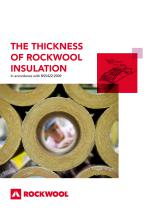
THE THICKNESS OF ROCKWOOL INSULATION In accordance with BS5422:2009
Abrir o catálogo na página 1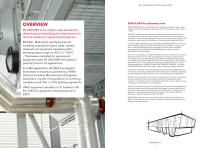
THE THICKNESS OF ROCKWOOL INSULATION OVERVIEW BS 5422:2009 is the industry wide standard for determining and specifying the requirements for thermal insulation to pipework & equipment. BS 5422 - Method for specifying thermal insulating materials for pipes, tanks, vessels, ductwork and equipment operating within the temperature range of –40°C to +700°C - Thicknesses calculated for services and equipment under BS 5422:2009 are based on practical limits for all applications. For H&V applications, BS 5422 has adopted thicknesses of insulation published by TIMSA (Thermal Insulation Manufacturers...
Abrir o catálogo na página 2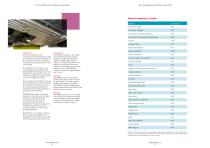
THE THICKNESS OF ROCKWOOL INSULATION THE THICKNESS OF ROCKWOOL INSULATION Surface emissivity (£) table Material CE Marking With the introduction of the Construction Products Regulation (CPR), CE marking has become mandatory for all construction products covered by a harmonised technical specification as of 1st July 2013. This regulation is an EU law and has been adopted by all member states including the United Kingdom. It is now illegal to sell any products covered by a harmonized European standard which are not CE marked accordingly. This new approach standardises the key features of...
Abrir o catálogo na página 3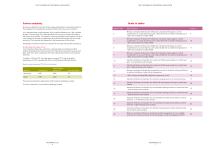
THE THICKNESS OF ROCKWOOL INSULATION THE THICKNESS OF ROCKWOOL INSULATION Surface emissivity Emissivity is defined as the ratio of the energy radiated from a material's surface to that radiated from a blackbody (a perfect emitter) under the same conditions. It is a dimensionless number between 0 (for a perfect reflector) and 1 (for a perfect emitter). The emissivity of a surface depends not only on the material but also on the nature of the surface. For example, a clean and polished metal surface will have a low emissivity, whereas a roughened and oxidised metal surface will have a high...
Abrir o catálogo na página 4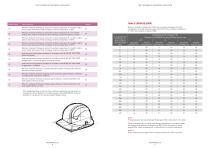
THE THICKNESS OF ROCKWOOL INSULATION THE THICKNESS OF ROCKWOOL INSULATION Page no. Table 6 (BS5422:2009) Minimum insulation thickness for chilled and cold water steel pipes to control condensation on a high emissivity outer surface (0.9) with an ambient temperature of +25°C and a relative humidity of 80% Table reference Minimum insulation thickness to control the surface temperature of a metallic surface with a surface emissivity of 0.05 and design cold face temperature of 50°C Minimum insulation thickness to control the surface temperature of a non-metallic surface with a surface...
Abrir o catálogo na página 5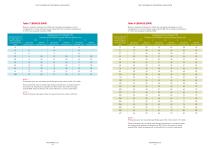
Table 7 (BS5422:2009) Minimum insulation thickness for chilled and cold water steel pipes to control condensation on a high emissivity outer surface (0.9) with an ambient temperature of +25°C and a relative humidity of 80% NOTE 1 Thicknesses given are calculated specifically against the criteria noted in the table. These thicknesses may not satisfy other design requirements. In situations where the ambient air temperature is greater than 25°C and/or the relative humidity exceeds 80%, these thicknesses will not be sufficient to control condensation. NOTE 2 These thicknesses only apply where...
Abrir o catálogo na página 6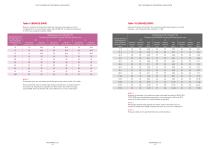
THE THICKNESS OF ROCKWOOL INSULATION THE THICKNESS OF ROCKWOOL INSULATION Table 9 (BS5422:2009) Minimum insulation thickness for chilled and cold water steel pipes to control condensation on a low emissivity outer surface (0.05) with an ambient temperature of +25°C and a relative humidity of 80% NOTE 1 Insulation thicknesses in this table have been calculated according to BS EN ISO 12241:2008 using standardised assumptions: horizontal pipe in still air at 25°C, emissivity of outer surface of insulated system as specified. NOTE 2 Thicknesses derived solely against the criteria noted in this...
Abrir o catálogo na página 7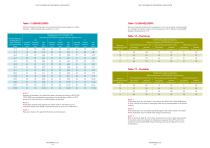
THE THICKNESS OF ROCKWOOL INSULATION THE THICKNESS OF ROCKWOOL INSULATION External surface emissivity Minimum thickness of ROCKWOOL Ductwrap (mm) Table 11 (BS5422:2009) Indicative thickness of insulation for cooled and chilled water systems to control heat gain - high emissivity outer surfaces (£ = 0.9) NOTE 1 Insulation thicknesses in this table have been calculated according to BS EN ISO 12241:2008 using standardised assumptions: horizontal pipe in still air at 25°C, emissivity of outer surface of insulated system as specified. NOTE 2 Thicknesses derived solely against the criteria noted...
Abrir o catálogo na página 8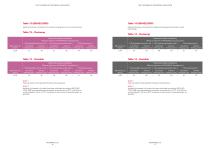
THE THICKNESS OF ROCKWOOL INSULATION Table 13 (BS5422:2009) Table 14 (BS5422:2009) Indicative thickness of insulation for ductwork carrying warm air to control heat loss. Indicative thickness of insulation for chilled and dual-purpose ducting to control heat transfer. NOTE 1 Heat loss relates to the specified thickness and temperature. NOTE 2 Insulation thicknesses in this table have been calculated according to BS EN ISO 12241:2008 using standardised assumptions: horizontal duct at 35°C, with 600 mm vertical sidewall in still air at 15°C, emissivity of outer surface of insulated system as...
Abrir o catálogo na página 9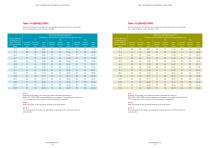
THE THICKNESS OF ROCKWOOL INSULATION THE THICKNESS OF ROCKWOOL INSULATION Table 15 (BS5422:2009) Indicative thickness of insulation for non-domestic heating services to control heat loss - low emissivity outer surfaces (£ =0.05) NOTE 1 Insulation thicknesses in this table have been calculated according to BS EN ISO 12241:2008 using standardised assumptions: horizontal pipe in still air at 15°C, emissivity of outer surface of insulated system as specified. NOTE 2 Heat loss relates to the specified thickness and temperature. NOTE 3 The thicknesses in this table are applicable to pipes serving...
Abrir o catálogo na página 10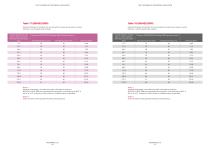
THE THICKNESS OF ROCKWOOL INSULATION THE THICKNESS OF ROCKWOOL INSULATION Table 17 (BS5422:2009) Indicative thickness of insulation for non-domestic hot water service areas to control heat loss - low emissivity outer surfaces NOTE 1 Insulation thicknesses in this table have been calculated according to BS EN ISO 12241:2008 using standardised assumptions: horizontal pipe at 60°C in still air at 15°C, emissivity of outer surface of insulated system as specified. NOTE 2 Heat loss relates to the specified thickness and temperature. NOTE 1 Insulation thicknesses in this table have been...
Abrir o catálogo na página 11Todos os catálogos e folhetos técnicos da ROCKWOOL
-
NyRock® Rainscreen 032
10 Páginas
-
OSCB Contractors’ Guide
16 Páginas
-
Fire Duct
5 Páginas
-
NyRock® Frame Slab 032
7 Páginas
-
CAVITY
12 Páginas
-
hardrock-ub34-datasheet
5 Páginas
-
ductslab-ductwrap
12 Páginas
-
tcb--pcwb-datasheet
12 Páginas
-
RAINSCREEN DUO SLAB®
14 Páginas
-
intumescent-pillows-ce-datasheet
12 Páginas
-
firepro-book
109 Páginas
-
Flat Roof Acoustic Reference Guide
7 Páginas
-
Product Application Guide
37 Páginas
-
SP FIRESTOP VRB
8 Páginas
-
CLADDING ROLL
12 Páginas
-
FIRE BARRIER SYSTEM
20 Páginas
-
RW SEMI-RIGID AND RIGID SLABS
7 Páginas
-
Twinroll
8 Páginas
-
FLEXI®
20 Páginas
-
BEAMCLAD® System
16 Páginas
-
Ablative Coated Batt
8 Páginas
-
Fire Duct Systems
16 Páginas
-
ROCKFRAME
4 Páginas
-
SANDWICH PANELS
6 Páginas
-
Redart silicone
5 Páginas
-
Rockwool techwrap & techtube
4 Páginas
-
DUCTSLAB AND DUCTWRAP
8 Páginas
-
Rockwool vrb
3 Páginas
-
THERMAL & SOUND RANGE OVERVIEW
2 Páginas
-
ROCKPRIME®
2 Páginas
-
THE SMOKE REPORT
20 Páginas
-
*NEW* ROCKWOOL TRADE RANGE
2 Páginas
-
FLAT ROOF APPLICATION GUIDE
32 Páginas
-
HARDROCK® MULTI-FIX TAPERED
1 Páginas
-
METAL DECK ACOUSTIC PERFORMANCE
1 Páginas
-
CASE STUDY: SPORTS ARENA LONDON
2 Páginas
-
SOCIAL HOUSING BROCHURE
7 Páginas
-
EWI INTRODUCTORY GUIDE FOR RESIDENTS
2 Páginas
-
FIREPRO® SOFTSEAL
8 Páginas
-
SAFER BUILDINGS
12 Páginas
-
HARDROCK® MULTI-FIX SOLUTION
16 Páginas
-
BRICKSHIELD®
6 Páginas
-
ROCKSHELL® BUILDING AND CONSTRUCTION
20 Páginas
-
FIREPRO® DUCT WORK
4 Páginas
-
PART L PIPES AND DUCTS
12 Páginas
-
FIREPRO® GLUE
4 Páginas
-
ENERGYSAVER®
8 Páginas
-
BRICK EFFECT RENDER
3 Páginas
-
ACOUSTIC MEMBRANE
5 Páginas
-
ACOUSTIC INTUMESCENT SEALANT
4 Páginas
-
ACOUSTIC INFILL
4 Páginas
-
RECYCLING
4 Páginas
-
EDC
8 Páginas
-
ROCKSHELL® DESIGN AND PROJECT PLANNING
20 Páginas
-
ENERGYSAVER®
2 Páginas
-
CORE RANGE
24 Páginas
-
CORROSION
20 Páginas
-
building_and_construction
20 Páginas
-
INTUMESCENT PUTTY PADS external
4 Páginas
-
hardrockdualdensitydatasheet
16 Páginas
-
acoustic party wall
4 Páginas
-
firepro book final
88 Páginas











































































